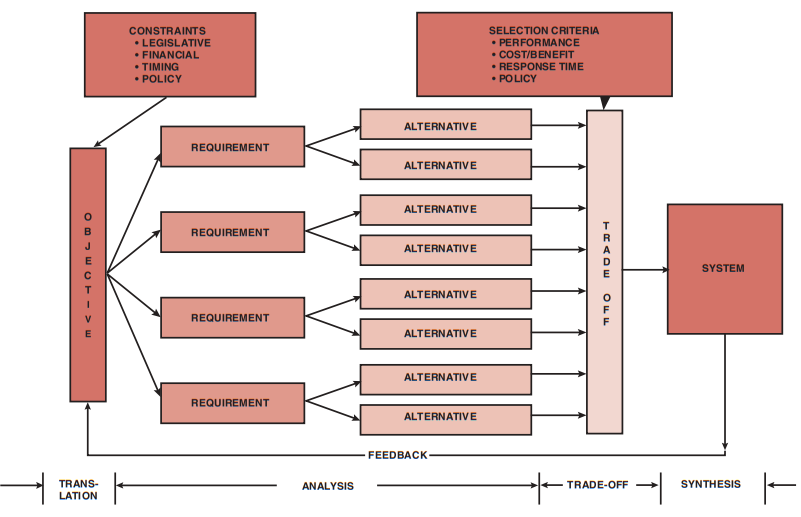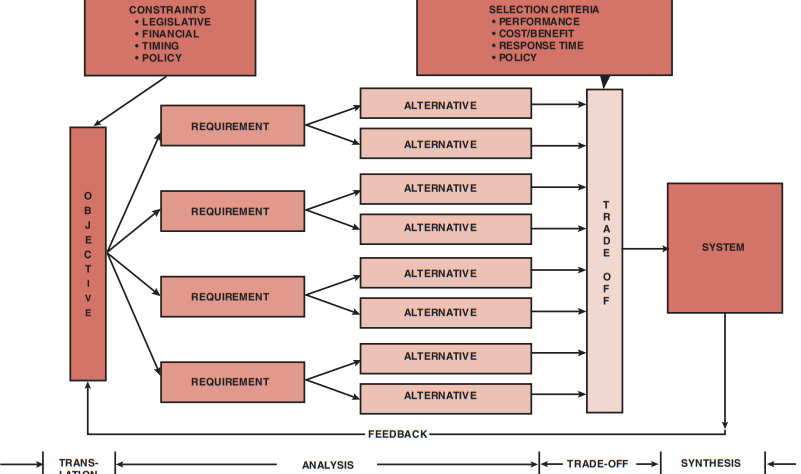Ultimately, all decisions and policies are made on the basis of judgments; there is no other way, and there never will be. In the end, analysis is but an aid to the judgment and intuition of the decision maker. These principles hold true for project management as well as for systems management.
The systems approach may be defined as a logical and disciplined process of problem solving. The word process indicates an active ongoing system that is fed by input from its parts.
The systems approach:
● Forces review of the relationship of the various subsystems
● Is a dynamic process that integrates all activities into a meaningful total system
● Systematically assembles and matches the parts of the system into a unified whole
● Seeks an optimal solution or strategy in solving a problem
The systems approach to problem-solving has phases of development similar to the lifecycle phases shown in Figure 2–22. These phases are defined as follows:
● Translation: Terminology, problem objective, and criteria and constraints are defined and accepted by all participants.
● Analysis: All possible approaches to or alternatives to the solution of the problem are stated.
● Trade-off: Selection criteria and constraints are applied to the alternatives to meet the objective.
● Synthesis: The best solution in reaching the objective of the system is the result of the combination of analysis and trade-off phases.
Other terms essential to the systems approach are:
● Objective: The function of the system or the strategy that must be achieved.
● Requirement: A partial need to satisfy the objective.
● Alternative: One of the selected ways to implement and satisfy a requirement.
● Selection criteria: Performance factors used in evaluating the alternatives to select a preferable alternative.
● Constraint: An absolute factor that describes conditions that the alternatives must meet.
A common error by potential decision makers (those dissatisfied individuals with authority to act) who base their thinking solely on subjective experience, judgment, and intuition is that they fail to recognize the existence of alternatives. Subjective thinking is inhibited or affected by personal bias.
Objective thinking, on the other hand, is a fundamental characteristic of the systems approach and is exhibited or characterized by emphasis on the tendency to view events, phenomena, and ideas as external and apart from self-consciousness. Objective thinking is unprejudiced.
The systems analysis process, as shown in Figure 2–29, begins with systematic examination and comparison of those alternative actions that are related to the accomplishment of the desired objective. The alternatives are then compared on the basis of the resource costs and the associated benefits. The loop is then completed using feedback to
determine how compatible each alternative is with the objectives of the organization.
The above analysis can be arranged in steps:
● Input data to mental process
● Analyze data
● Predict outcomes
● Evaluate outcomes and compare alternatives
● Choose the best alternative
● Take action
● Measure results and compare them with predictions
The systems approach is most effective if individuals can be trained to be ready with alternative actions that directly tie in with the prediction of outcomes. The basic tool is the outcome array, which represents the matrix of all possible circumstances. This outcome array can be developed only if the decision maker thinks in terms of the wide scope of possible outcomes. Outcome descriptions force the decision maker to spell out clearly just what he is trying to achieve (i.e., his objectives).
Systems thinking is vital for the success of a project. Project management systems urgently need new ways of strategically viewing, questioning, and analyzing project needs for alternative nontechnical and technical solutions. The ability to analyze the total project, rather than the individual parts, is essential for successful project management.

Source : Project management A system approach to planning, scheduling and controlling [EIGHTH EDITION] By HAROLD KERZNER, Ph.D.
